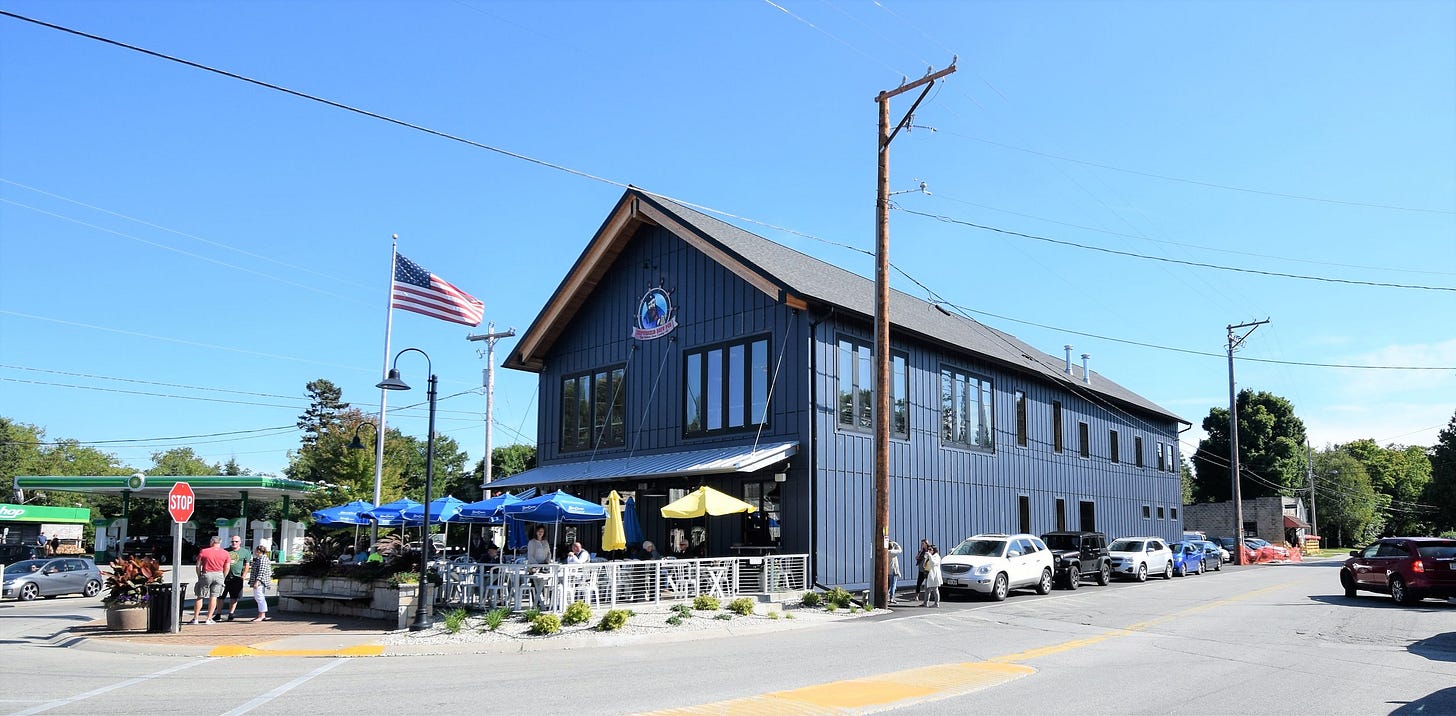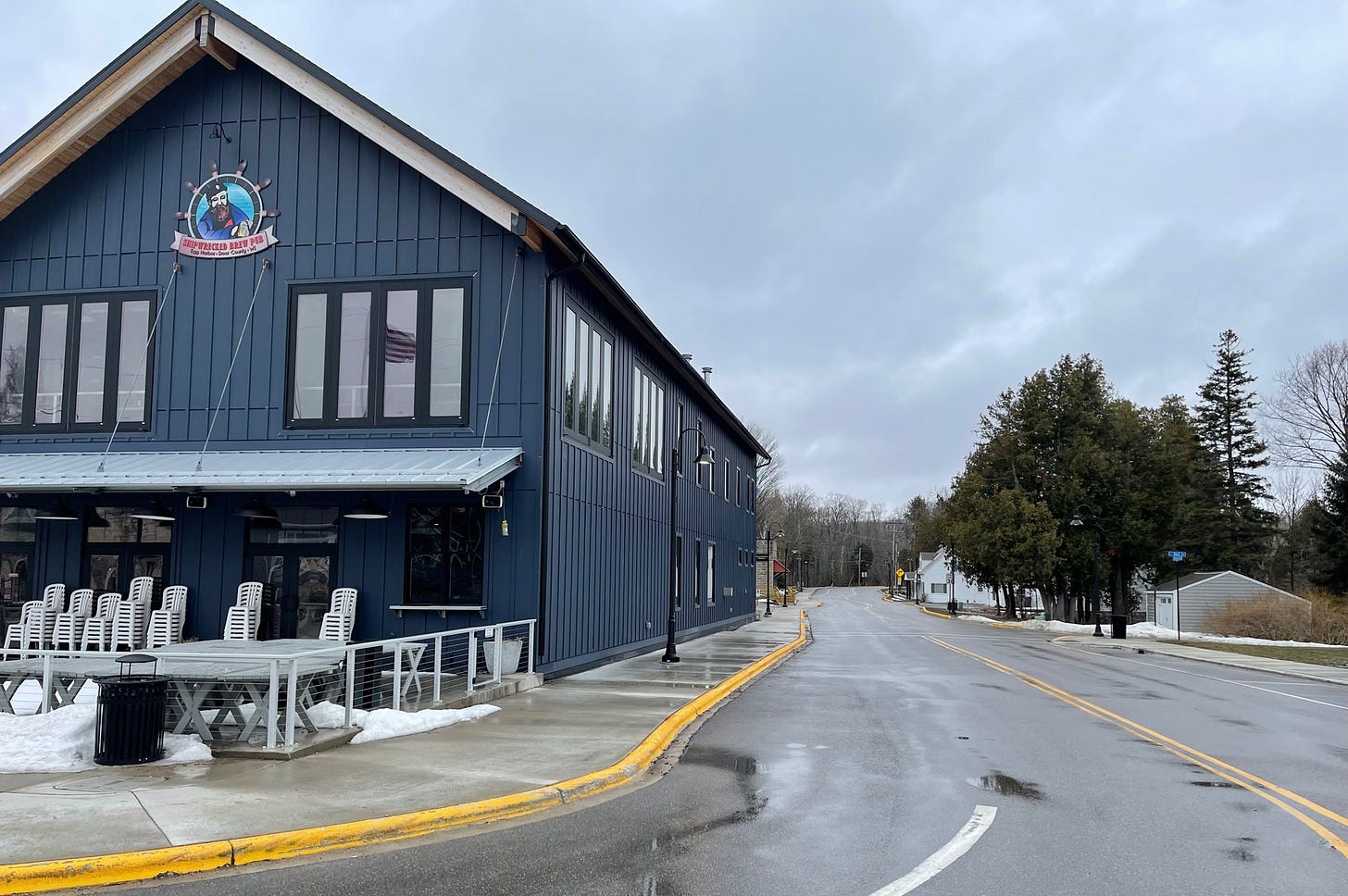Is a Sidewalk a Pedestrian Way?
Wisconsin Supreme Court answers "no" in a 4-3 decision interpreting statutory restriction on eminent domain power
The Shipwrecked Brew Pub & Restaurant in Egg Harbor is one of Door County’s better-known attractions. It was long rumored that the microbrewery’s original building, built in 1882, was haunted by the ghost of Al Capone’s illegitimate son. The original building burned in August of 2017, and Shipwrecked quickly rebuilt into the modern brew pub that now sits on the corner of County Highway G and State Highway 42 in Egg Harbor.
Last week, Shipwrecked was in the news for a new reason—one that didn’t involve ghosts, fires, or even beer. In Sojenhomer LLC v. Village of Egg Harbor, 2024 WI 25, a closely divided Wisconsin Supreme Court ruled that Egg Harbor properly condemned 0.009 acres of Shipwrecked’s property to build a sidewalk. (Shipwrecked is operated by Sojenhomer LLC, the plaintiff in this case, but I’ll refer to it as Shipwrecked.) The dispute focused entirely on whether the new sidewalk qualified as a “pedestrian way,” as that term is defined by statute.
To set the scene, here’s what Shipwrecked looked like before the Village’s condemnation action. Take note of the vehicles parked alongside the building on what was then part of Shipwrecked’s property.
And here’s what Shipwrecked looked like after the condemnation action. Note that the private parking spaces alongside the building have now been replaced with a publicly-owned sidewalk.
Shipwrecked sued to challenge Egg Harbor’s right to take the strip of land, arguing the condemnation was prohibited by Wis. Stat. § 32.015. That statute says, “Property may not be acquired by condemnation to establish or extend . . . a pedestrian way, as defined in s. 346.02(8)(a).” In turn, Wis. Stat. § 846.02(8)(a) provides the following definition: “A pedestrian way means a walk designated for the use of pedestrian travel.”
In Shipwrecked’s view, a sidewalk qualifies as a “pedestrian way” because—well—it’s ”a walk designated for the use of pedestrian travel.” Thus, Shipwrecked argued, the Village’s use of the condemnation power to obtain land for a sidewalk was barred by § 32.015’s prohibition on using that power to build a pedestrian way.
Strong argument. And the court of appeals agreed with it. In an opinion authored by Judge Hruz last year, the court of appeals held, “The general definition of a pedestrian way in Wis. Stat. § 32.015 . . . is broad and plainly includes sidewalks because a sidewalk is a ‘walk designated for the use of pedestrian travel.’”
In a 4-3 decision authored by Justice Dallet, and joined by Justices Ann Walsh Bradley, Karofsky, and Protaseiwicz, the supreme court reversed. And honestly, despite the intuitive appeal of Shipwrecked’s textual argument, the majority makes a strong case that, when read in light of the relevant statutory context, sidewalks and pedestrian ways are distinct, non-overlapping terms.
Reviewing statutory context, such as by evaluating surrounding and related statutes, is part and parcel of a plain meaning analysis. As Justice Dallet explained for the majority: “The ordinary meaning of a statute is dictated by more than the literal meaning of a single phrase, read in isolation. Rather, as we have emphasized before, statutes must be interpreted in their entirety, and in context.”
But that prompts the question: What context could suggest that a sidewalk is not a “walk designated for the use of pedestrian travel”?
For starters, the majority pointed to the context in § 346.02(8), where the definition of “pedestrian way” is found. In full, that subsection provides:
(a) All of the applicable provisions of this chapter pertaining to highways, streets, alleys, roadways and sidewalks also apply to pedestrian ways. A pedestrian way means a walk designated for the use of pedestrian travel.
(b) Public utilities may be installed either above or below a pedestrian way, and assessments may be made therefor as if such pedestrian way were a highway, street, alley, roadway or sidewalk.
The majority draws a few inferences from this text. First, these paragraphs use the terms “pedestrian ways” and “sidewalks” differently, suggesting they are distinct terms. In paragraph (a), for example, why would the statute have to clarify that the chapter’s provisions which apply to sidewalks also apply to pedestrian ways if sidewalks already qualify as pedestrian ways? And why would paragraph (b) have to say that public utilities may be installed by pedestrian ways “as if” the pedestrian way were a sidewalk if sidewalks already were pedestrian ways? The better reading, the majority held, was that “the side-by-side references to sidewalks and pedestrian ways in § 346.02(2) . . . indicates that these terms have separate, non-overlapping meanings.”
Justice Dallet’s majority opinion also advanced a few other contextual arguments. Perhaps most persuasively, she observes that the prohibition on using eminent domain power for sidewalks does not explicitly include sidewalks, even though “sidewalk” is a defined term under Wis. Stat. § 340.01(58). Given this definition, the majority concludes, “If the legislature wanted to prohibit the use of condemnation to build sidewalks anywhere in the state, then they could have done so clearly.” Instead, it’s more likely the legislature used the term “pedestrian ways”—and omitted the term “sidewalks”—because its aim was to prohibit the use of eminent domain for things like off-street walkways, nature trails, and the like.
In the dissent’s view, all this is just too clever by half. Chief Justice Ziegler authored a dissent, which was joined by Justices Rebecca Grassl Bradley and Hagedorn, in which she argued—more or less—the text is the text. The following excerpt from the introduction to her opinion sums up the dissent’s text-driven argument:
The plain language of the statute demonstrates that the term “pedestrian way” is broadly defined, and includes sidewalks. A sidewalk—that portion of the highway created for the travel of persons on foot—is clearly a subset of pedestrian ways—walks set apart or assigned for the use of pedestrian travel. It is a straightforward, common sense interpretation of the statutory language that a “walk designated for the use of pedestrian travel” necessarily includes that part of the highway “constructed for the use of pedestrians” and intended “for the use of persons on foot.” The Village exceeded its condemnation authority when it acquired Sojenhomer’s property through condemnation to construct a sidewalk. In other words, a closer look at the plain meaning of the statutes reveals that all sidewalks are pedestrian ways, but that not all pedestrian ways are sidewalks.
And what does the dissent think of the majority’s reliance on statutory context to reach the opposite conclusion?
The majority skips right over the plain language of the statutes and their common sense interpretation. Instead, the majority fixates on invented context. But the context it invents does not alter the common sense conclusion that the statutory definitions lead to: Sidewalks are pedestrian ways.
In my view, this case was a close call. Neither the majority nor the dissent offer an airtight rationale for their preferred interpretation. The specific text at issue certainly favors the dissent’s view, but the broader context does support the majority’s narrower understanding of what qualifies as a pedestrian way. Ahead of oral argument, James Sosnoski and I discussed this case at length on our podcast segment, Up for Review (beginning at 39:24). At that time, we correctly predicted that the court would reverse, noting that the consequence of adopting Shipwrecked’s argument would be that eminent domain could never be used to widen a road with sidewalks. It seems unlikely—though perhaps not inconceivable—that the legislature’s goal was to eliminate the use of the eminent domain power to widen roads with sidewalks, but not roads without sidewalks.
The decision has garnered (mostly negative) attention among legal scholars and bloggers outside Wisconsin (see posts by Ilya Somin and Johnathan Turley).






